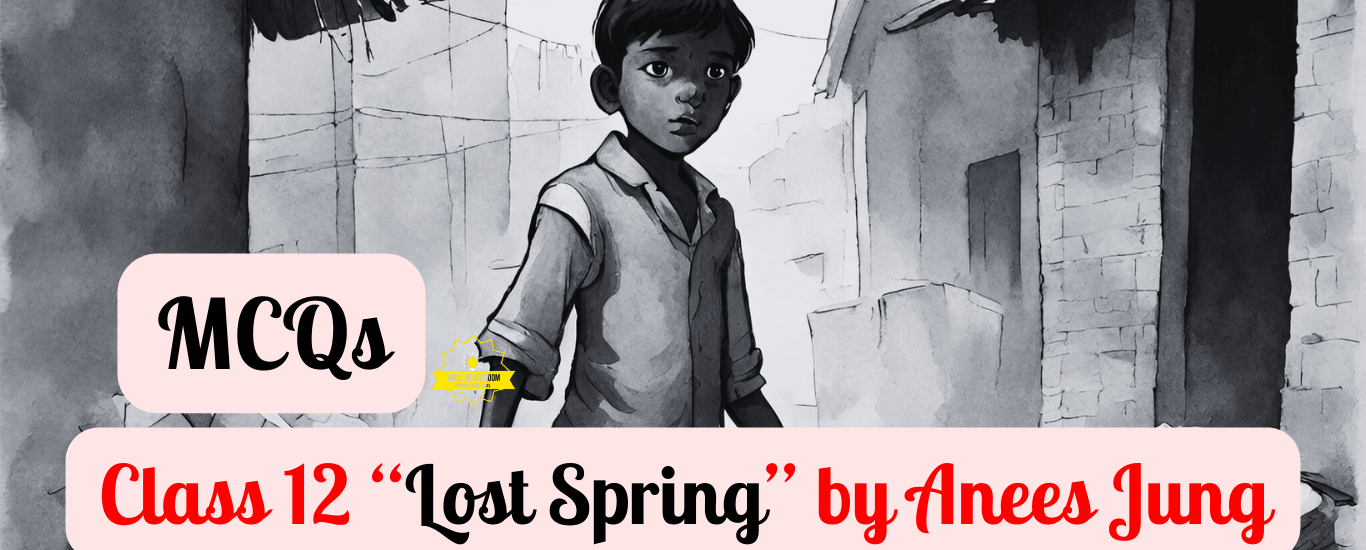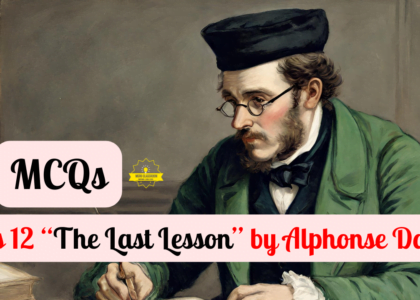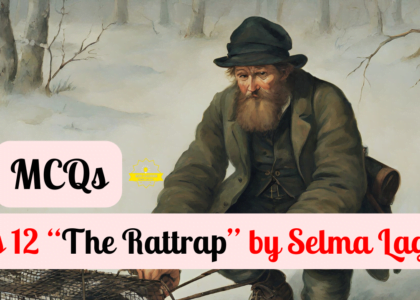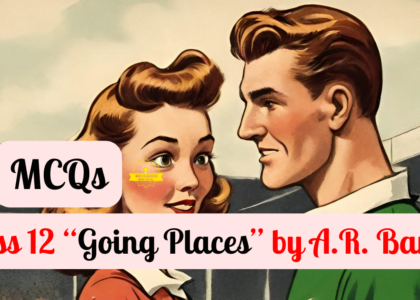Multiple-choice questions (Lost Spring MCQ) based on Chapter 2 of “Lost Spring” by Anees Jung. Explore themes of poverty, resilience, caste dynamics, and societal expectations through Saheb and Mukesh’s stories.
Table of Contents:
Also Read: Complete Guide on Chapter 2 “Lost Spring”
Chapter 2- Lost Spring MCQ
The excerpt from “Lost Spring: Stories of Stolen Childhood” by Anees Jung delves into the lives of impoverished children in India, mainly focusing on Saheb and Mukesh, whose childhoods are marred by poverty and exploitation.
Set I
Total Questions- 30
1. What is the main reason Saheb scrounges for gold in the garbage dumps?
a) He enjoys the thrill of scavenging.
b) He wants to find valuables to sell.
c) He is searching for lost treasures.
d) He is looking for discarded items for personal use.
2. Why does Saheb claim he scrounges for gold in the garbage dumps?
a) He has no other means of earning money.
b) He enjoys exploring garbage dumps.
c) He hopes to find valuable items to sell for profit.
d) He finds it amusing to scavenge through trash.
3. What is the author’s response when Saheb mentions he has nothing else to do?
a) Encourages him to find a job.
b) Advises him to go to school.
c) Suggests he explores other hobbies.
d) He recommends travelling to a different city.
4. Why does Saheb say he hasn’t attended school?
a) There is no school in his neighbourhood.
b) He dislikes studying and prefers working.
c) His family cannot afford to send him to school.
d) He prefers to scrounge for gold instead.
5. What does the author propose to Saheb regarding education?
a) To start a new school in the neighbourhood.
b) To enrol in a nearby school.
c) To seek education opportunities elsewhere.
d) To wait until a school is built in his neighbourhood.
6. How does Saheb respond to the author’s offer to start a school?
a) He declines the offer politely.
b) He expresses enthusiasm and agrees to attend.
c) He remains indifferent to the suggestion.
d) He promises to think about it but doesn’t commit.
7. How does Saheb react when the author jokes about the school being ready?
a) He expresses excitement and eagerness to attend.
b) He expresses disappointment at the delay.
c) He remains indifferent and doesn’t respond.
d) He appreciates the author’s sense of humour.
8. What is the significance of Saheb’s name, “Saheb-e-Alam”?
a) It means “lord of the universe.”
b) It signifies his role as a leader in his community.
c) It represents his aspirations for a better future.
d) It reflects his connection to his homeland.
9. What observation does the author make about the children she encounters in the neighbourhood?
a) They are always barefoot, regardless of the weather.
b) They are often seen playing in the garbage dumps.
c) They appear carefree and unburdened by their circumstances.
d) They need access to basic necessities like shoes.
10. What does one of the boys mention about his shoes?
a) His mother forgot to bring them down from the shelf.
b) He prefers to go barefoot regardless of his shoes.
c) He lost them while playing in the neighbourhood.
d) He dislikes the shoes his mother brought for him.
11. What does the author wonder about the tradition of going barefoot?
a) If it is a genuine tradition or an excuse for poverty.
b) If it is a symbol of defiance against societal norms.
c) If it is a cultural practice prevalent in their community.
d) If it is a religious requirement in their culture.
12. What prompts the author to visit Seemapuri, a place on the periphery of Delhi?
a) Her curiosity about the lives of marginalised communities.
b) Her desire to learn about the ragpickers’ way of life.
c) She is interested in exploring different neighbourhoods in Delhi.
d) she intended to help improve living conditions in Seemapuri.
13. What is the author’s observation about the ragpickers in Seemapuri?
a) They have lived there for over thirty years without identity.
b) They have been granted official permits to reside there.
c) They have access to basic amenities like sewage and drainage.
d) They have established a thriving community with proper infrastructure.
14. What does Saheb consider garbage to be?
a) A source of income and livelihood.
b) A reflection of societal neglect and indifference.
c) A means of survival and sustenance.
d) A symbol of poverty and exploitation.
15. Why does Saheb enjoy finding a rupee or a ten-rupee note in the garbage?
a) He considers it a sign of good luck and fortune.
b) He sees it as a reward for his hard work and perseverance.
c) He believes there is a more valuable treasure to be found.
d) He enjoys the excitement and thrill of scavenging.
16. What is Saheb’s attitude towards the tennis game he watches?
a) He feels a sense of longing and desire to play.
b) He is content to watch from a distance without participating.
c) He dreams of one day owning and playing a tennis racket.
d) He admires the skill and athleticism of the players.
17. What does the author notice about Saheb’s tennis shoes?
a) They are brand new and expensive.
b) They need to be matched and worn out.
c) They are discarded shoes of a wealthy child.
d) They symbolise status and privilege.
18. What does the author reflect upon when she sees the priest’s son wearing shoes?
a) The disparity between privileged and underprivileged children.
b) The impact of prayers and wishes coming true.
c) The significance of material possessions in society.
d) The changing fortunes of individuals over time.
19. How does the author describe Seemapuri about Delhi?
a) It is an integral part of Delhi’s urban landscape.
b) It is a vibrant and bustling neighbourhood in Delhi.
c) It is located on the periphery of Delhi but distant metaphorically.
d) It is a secluded and remote area in Delhi’s heart.
20. What is the author’s perception of Seemapuri’s residents’ preference for living there?
a) They prioritise basic necessities like food over identity.
b) They value community bonds and collective survival.
c) They are resigned to their circumstances and lack ambition.
d) They prioritise comfort and convenience over identity.
21. What is the significance of the ragpickers’ ration cards?
a) They enable them to purchase essential goods like grain.
b) They grant them access to government subsidies and aid.
c) They officially recognise their residency status.
d) They serve as proof of identity and citizenship.
22. What motivates the ragpickers to continue living in Seemapuri despite its challenges?
a) The promise of better opportunities and living conditions.
b) The absence of alternative housing options or resources.
c) The sense of community and solidarity among residents.
d) The desire to reclaim their lost homeland and identity.
23. What does the author suggest about the perception of garbage among children and adults?
a) Children view garbage with wonder and curiosity, while adults see it as a means of survival.
b) Children and adults view garbage as a societal neglect and indifference symbol.
c) Children perceive garbage as a source of excitement and treasure, while adults see it as a burden.
d) Children and adults see garbage as an inevitable aspect of their daily lives.
24. How does Saheb view the tennis game he watches from behind the fence?
a) He feels a sense of longing and frustration at being unable to play.
b) He is content to watch from a distance, finding solace in the game.
c) He dreams of one day becoming a professional tennis player.
d) He admires the players’ skills but has yet to desire to participate.
25. What does the author suggest about the discarded tennis shoes Saheb wears?
a) They represent a materialistic mindset prevalent in society.
b) They symbolise the disparity between rich and poor children.
c) They reflect Saheb’s resilience and ability to adapt to circumstances.
d) They highlight the generosity of those who donate to the less fortunate.
26. What do Saheb’s experiences with garbage and tennis shoes reveal about his aspirations?
a) He dreams of a life beyond poverty and exploitation.
b) He finds contentment and joy in simple pleasures and treasures.
c) He harbours resentment towards those who live more privileged lives.
d) He struggles to reconcile his dreams with the reality of his circumstances.
27. What does the author imply about the socioeconomic disparities in Saheb’s community?
a) Systemic injustices and societal neglect exacerbate them.
b) The indifference of privileged individuals perpetuates them.
c) They are reflected in the unequal distribution of resources and opportunities.
d) The resilience and resourcefulness of marginalised communities challenge them.
28. How do Saheb’s experiences with garbage and tennis shoes symbolise his resilience?
a) They demonstrate his ability to find value and meaning in adversity.
b) They represent his determination to overcome poverty and exploitation.
c) They highlight his willingness to adapt to changing circumstances.
d) They signify his capacity to find joy and contentment amidst hardship.
29. What is the author’s purpose in sharing Saheb’s story and experiences?
a) To raise awareness about the plight of marginalised communities.
b) To inspire readers to take action and support grassroots initiatives.
c) To challenge societal norms and perceptions about poverty and exploitation.
d) To shed light on the resilience and dignity of individuals living in adversity.
30. What theme is most prominent in the excerpt?
a) Resilience in the face of adversity.
b) The impact of socioeconomic disparities.
c) The importance of community and solidarity.
d) The humanising power of storytelling.
Answers- Set I
- b) He wants to find valuables to sell.
- a) He has no other means of earning money.
- b) Advises him to go to school.
- a) There is no school in his neighbourhood.
- d) To wait until a school is built in his neighbourhood.
- b) He expresses enthusiasm and agrees to attend.
- c) He remains indifferent and doesn’t respond.
- a) It means “lord of the universe.”
- d) They need access to basic necessities like shoes.
- a) His mother forgot to bring them down from the shelf.
- a) If it is a genuine tradition or an excuse for poverty.
- b) Her desire to learn about the ragpickers’ way of life.
- a) They have lived there for over thirty years without identity.
- c) A means of survival and sustenance.
- b) He sees it as a reward for his hard work and perseverance.
- b) He is content to watch from a distance without participating.
- c) They are discarded shoes of a wealthy child.
- d) The changing fortunes of individuals over time.
- c) It is located on the periphery of Delhi but distant metaphorically.
- a) They prioritise basic necessities like food over identity.
- a) They enable them to purchase essential goods like grain.
- c) The sense of community and solidarity among residents.
- a) Children view garbage with wonder and curiosity, while adults see it as a means of survival.
- b) He is content to watch from a distance, finding solace in the game.
- d) They highlight the generosity of those who donate to the less fortunate.
- a) He dreams of a life beyond poverty and exploitation.
- c) They are reflected in the unequal distribution of resources and opportunities.
- a) They demonstrate his ability to find value and meaning in adversity.
- d) To shed light on the resilience and dignity of individuals living in adversity.
- a) Resilience in the face of adversity.
Set II
Total Questions- 30
1. What job does Saheb currently hold?
a) Tea stall owner.
b) Milk booth operator.
c) Steel canister manufacturer.
d) Garbage collector.
2. What does Saheb indicate about his current job?
a) He dislikes the heavy canister.
b) He works without pay.
c) He enjoys his meals.
d) He dreams of being a motor mechanic.
3. What does Mukesh aspire to become?
a) A bangle maker.
b) A motor mechanic.
c) A glassblower.
d) A tailor.
4. Why is Mukesh’s dream considered challenging?
a) There needs to be more demand for motor mechanics.
b) It is illegal for children to work in glass furnaces.
c) He needs more interest in automobiles.
d) No garages in Firozabad.
5. What is the predominant occupation in Firozabad?
a) Glass blowing.
b) Bricklaying.
c) Agriculture.
d) Carpentry.
6. How does Mukesh’s grandmother view their family’s occupation?
a) As a curse.
b) As a privilege.
c) As an opportunity.
d) As a misfortune.
7. What do the young men in Firozabad voice the primary concern?
a) Lack of government support.
b) Middlemen exploitation.
c) Inadequate infrastructure.
d) Environmental pollution.
8. What hinders the young men from organising into a cooperative?
a) Fear of legal repercussions.
b) Lack of leadership.
c) Inadequate funds.
d) Government intervention.
9. What societal factors contribute to the perpetuation of poverty in Firozabad?
a) Lack of natural resources.
b) Excessive government regulation.
c) Exploitative middlemen.
d) Abundant job opportunities.
10. How does Mukesh differ from his peers in ambition?
a) He desires to work as a bangle maker.
b) He dreams of becoming a politician.
c) He aspires to be a motor mechanic.
d) He aims to continue the family tradition.
11. What is the main reason behind Saheb’s family’s migration from Dhaka to the big city?
a) Seeking better educational opportunities.
b) Escaping political unrest.
c) Searching for employment and stability.
d) Exploring new cultural experiences.
12. What does Saheb find fascinating about the tennis game he observes?
a) The strategy and skill involved.
b) The elegance and grace of the players.
c) The competitive nature of the sport.
d) The opportunity to play freely.
13. What does the author mean when describing Mukesh’s dream as a “mirage amidst the dust of streets”?
a) His dream needs to be revised and attainable.
b) His dream provides hope and inspiration.
c) His dream is constantly changing and evolving.
d) His dream is hidden beneath layers of hardship.
14. How does Mukesh’s grandmother perceive their family’s lineage in the context of their occupation?
a) As a generational burden, they cannot escape.
b) As a source of pride and honour.
c) As an opportunity for social mobility.
d) As a symbol of cultural heritage.
15. What societal barriers prevent Mukesh and others like him from pursuing alternative livelihoods?
a) Lack of education and skill development programs.
b) Discriminatory caste-based norms and expectations.
c) Limited access to financial resources and credit.
d) Absence of vocational training facilities.
16. Why does Savita’s future seem predetermined within the community?
a) Due to her lack of ambition and determination.
b) Societal expectations regarding gender roles.
c) Due to her family’s financial constraints.
d) Because she prefers traditional values.
17. How does Mukesh demonstrate a willingness to challenge societal norms and expectations?
a) By embracing his family’s occupation without question.
b) By advocating for better working conditions for banglemakers.
c) By expressing aspirations beyond his current circumstances.
d) By conforming to traditional gender roles within his household.
18. What parallels can be drawn between Saheb’s Seemapuri experiences and Mukesh’s Firozabad struggles?
a) Both face challenges associated with poverty and exploitation.
b) Both enjoy privileged access to educational opportunities.
c) Both actively participate in community-led development projects.
d) Both belong to affluent households with ample resources.
19. How do the aspirations of Saheb and Mukesh reflect their desire for autonomy and self-determination?
a) By prioritising family obligations over personal goals.
b) By seeking opportunities for personal and professional growth.
c) By conforming to societal expectations without question.
d) By relying on external support systems for guidance.
20. What themes emerge from the juxtaposition of Saheb and Mukesh’s narratives within the excerpt?
a) Resilience, ambition, and community solidarity.
b) Exploitation, poverty, and societal inequities.
c) Cultural heritage, tradition, and familial obligations.
d) Environmental degradation, urbanisation, and migration trends.
21. What does Saheb mention about his family’s migration from Dhaka?
a) Political instability forced them to flee.
b) Natural disasters destroyed their village.
c) They sought better economic opportunities in the city.
d) They were escaping persecution based on their caste.
22. What role does Mukesh’s grandmother play in their family dynamics?
a) She is the primary breadwinner.
b) She challenges traditional gender roles.
c) She enforces caste-based norms and traditions.
d) She advocates for educational opportunities for Mukesh.
23. How does Mukesh demonstrate resilience in the face of adversity?
a) By conforming to societal expectations.
b) By challenging the status quo.
c) By accepting his family’s fate.
d) By refusing to pursue his dreams.
24. What societal factors contribute to the perpetuation of poverty in Firozabad?
a) Lack of education and vocational training.
b) Caste-based discrimination and exploitation.
c) Access to modern technology and infrastructure.
d) Government policies promoting economic development.
25. How do Mukesh and Saheb’s aspirations challenge traditional community expectations?
a) By prioritising financial stability over personal fulfilment.
b) By advocating for gender equality and social justice.
c) By pursuing careers outside of their family’s traditional occupation.
d) By conforming to cultural norms and societal pressures.
26. What symbolic significance do bangles hold within the context of Firozabad’s culture?
a) They represent social status and wealth.
b) They signify a woman’s marital status and auspiciousness.
c) They symbolise artistic expression and creativity.
d) They serve as a form of currency in the local economy.
27. How does the excerpt portray the intergenerational cycle of poverty in Firozabad?
a) Through the pursuit of education and vocational training.
b) Through the perpetuation of caste-based occupations.
c) Through government intervention and social welfare programs.
d) Through access to modern technology and economic opportunities.
28. What challenges do young men like Mukesh’s face in breaking free from the cycle of poverty?
a) Lack of ambition and determination.
b) Limited access to educational and vocational resources.
c) Societal expectations and caste-based discrimination.
d) Absence of government support and infrastructure.
29. What societal norms and expectations limit Savita’s personal and professional growth opportunities?
a) Caste-based discrimination and patriarchal structures.
b) Lack of access to education and vocational training.
c) Economic instability and financial dependence.
d) Government policies promoting gender equality and social justice.
30. How do Mukesh and Saheb’s dreams reflect their social mobility and autonomy aspirations?
a) By conforming to traditional expectations and familial obligations.
b) By challenging caste-based discrimination and societal norms.
c) By seeking opportunities for personal and professional growth.
d) By prioritising communal solidarity and collective well-being.
Answers- Set II
- a) Tea stall owner.
- c) He enjoys his meals.
- b) A motor mechanic.
- b) It is illegal for children to work in glass furnaces.
- a) Glass blowing.
- b) As a privilege.
- b) Middlemen exploitation.
- a) Fear of legal repercussions.
- c) Exploitative middlemen.
- c) He aspires to be a motor mechanic.
- c) Searching for employment and stability.
- a) The strategy and skill involved.
- d) His dream is hidden beneath layers of hardship.
- a) As a generational burden, they cannot escape.
- b) Discriminatory caste-based norms and expectations.
- b) Societal expectations regarding gender roles.
- c) By expressing aspirations beyond his current circumstances.
- a) Both face challenges associated with poverty and exploitation.
- b) By seeking opportunities for personal and professional growth.
- b) Exploitation, poverty, and societal inequities.
- c) They sought better economic opportunities in the city.
- c) She enforces caste-based norms and traditions.
- b) By challenging the status quo.
- b) Caste-based discrimination and exploitation.
- c) By pursuing careers outside of their family’s traditional occupation.
- b) They signify a woman’s marital status and auspiciousness.
- b) Through the perpetuation of caste-based occupations.
- c) Societal expectations and caste-based discrimination.
- a) Caste-based discrimination and patriarchal structures.
- c) By seeking opportunities for personal and professional growth.





